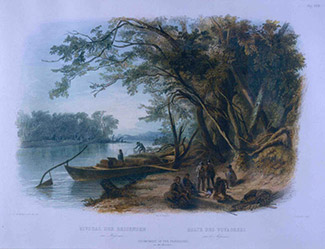21st Century Corps of Discovery Lecture
About

Encampment of travelers on the Missouri River, Karl Bodmer, The State Historical Society of Missouri
Two hundred years ago the Lewis and Clark expedition explored America's uncharted western territories, including the mid-Missouri region. They discovered more than 300 new plant, animal and fish species and recorded detailed anthropological findings. The expedition's joint efforts, known as the “Corps of Discovery,” provided extensive maps and other valuable information for America.
As the first public university west of the Mississippi River, the University of Missouri also has made a difference. For example, MU scientists and scholars discovered aureomycin, the first tetracycline antibiotic; improved the treatment and prevention of diabetes and helped develop home dialysis for kidney patients; discovered previously unpublished works by such famous authors as Mark Twain, Charlotte Bronte, Tennessee Williams, William Faulkner and Jack Kerouac; performed the world's first pediatric angioplasty to correct heart defects in babies; conducted landmark studies in crop rotation that led to advances in sustainable agriculture; and developed Mo17, the basis for much of today's hybrid corn.
Now in the 21st century, MU inventors and creators also are discoverers. Recent faculty contributions include a new process to repair damaged knees; a better cancer treatment using gold nanoparticles; hand-held X-rays; advances in older adult care; a heartburn drug called Zegerid; new knowledge to strengthen families; a breakthrough using gene therapy to treat muscular dystrophy; innovative journalism technologies; collagen-based tissue products; cutting-edge research on eating and exercise; and a novel soy-based food with the texture and consistency of chicken.